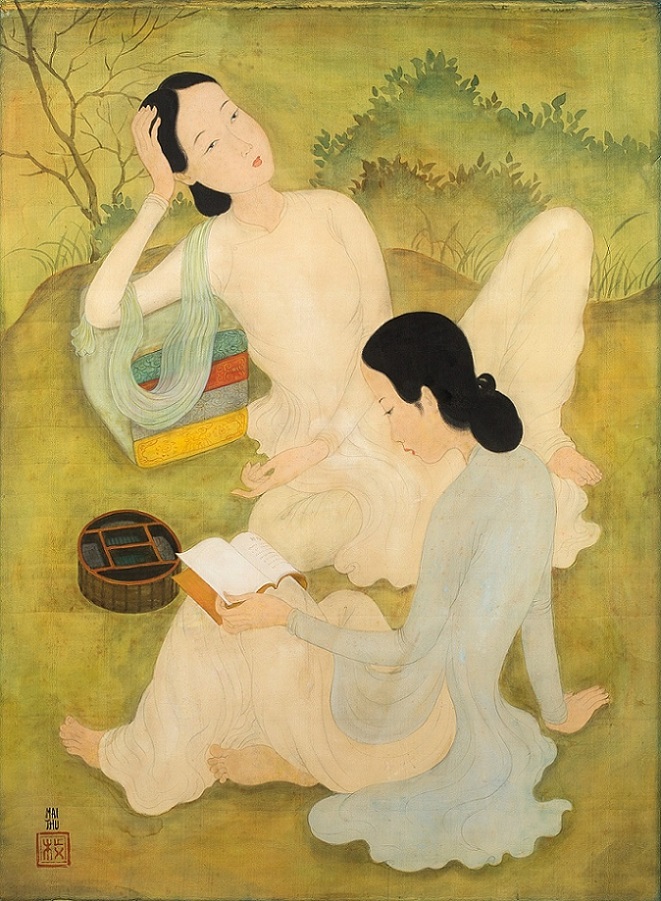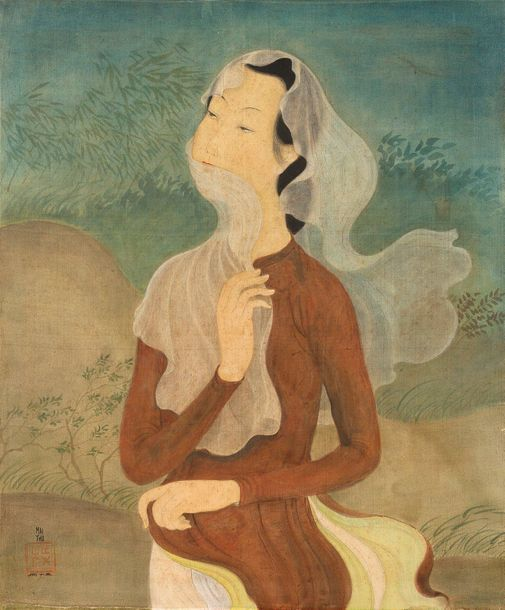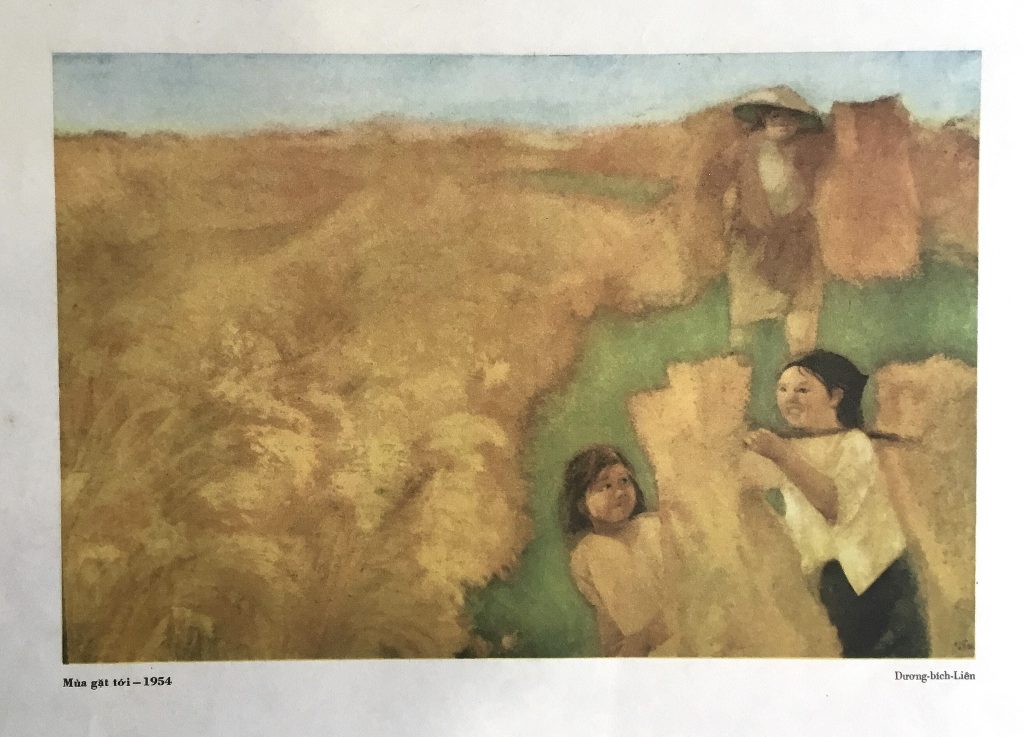There are questions about why in auctions of Vietnamese paintings, names like Lê Phổ, Mai Trung Thứ, Vũ Cao Đàm or artists of the early 20th century such as Phạm Hậu and Lương Xuân Nhị who studied at Indochina Fine Arts College always appear, while Việt Nam has a 100-year-old painting background, rich in identity with generations of artists, equally famous.
Basically, this is partly true. But the art market and the auction houses’ plans also depend on the source of the paintings brought to them or they search for them themselves, the trends of collectors, the names, positions, artistic value, and commercial value of the artists they introduce.
For foreign auction houses, the name of the artists with quality works is the guarantee for the success of the auctions. The more prestigious and high-quality the auction house is, the more it attracts both buyers and sellers, creating outstanding commercial value for the art market.

Mai Trung Thứ (1906-1980). En plein air. Silk. 1940. 54,6×45,2 cm.
Sold for 794.720 EUR in 2022 at Aguttes.

Mai Trung Thứ (1906-1980). The musician. Silk. 1946. 80,5×63,2 cm.
Sold for 297.080 EUR in 2018 at Aguttes.
A collector, the acquaintance of Viet Art View said that many – emphasizing “many” art brokers offer paintings and send via message paintings of famous artists from Indochina classes, Resistance class, Tô Ngọc Vân class with attractive price offers. And certainly, there is no “real or fake” test, let alone discussing whether the it is “quality” or not. These brokers say that the source of paintings by artist A and artist B that they introduce are very cheap… While collectors always need artistic value first, the prerequisite of whether to buy or not.
In addition, some brokers and “exchange” places post on online platforms many works with full descriptions (prices are of course inbox) and general introductions. Most of what art lovers need, such as origin, provenance, artistic value, and beauty of the work, are hard to find.
So, why are works of art beautiful and valuable? Not everyone can answer this clearly and coherently in a systematic, theoretical and academic basis.
For example, if we think that the paintings created of oil by Lê Phổ may have a similar price. The date before and after may be a bit more expensive; Or if the size of the painting is large, it will cost more… that’s only partly true. But what creates the value of a work must be “the intrinsic value of the visual surface, the story, and the subject it contains”, if we want to explain clearly when we are not experts, it is difficult to place them correctly.

Mai Trung Thứ (1906-1980). Le collier. Silk. 1944. 55×71 cm.
Sold for 3,3 million HKD in 2023 at Bonhams.

Mai Trung Thứ (1906-1980). The mother and her sleeping child.
Silk. 1944. 54,6×45,2 cm.
Sold for 462.960 EUR in 2023 at Aguttes.
In the article “Jonathan Rendell – How I look at a house” (source: Christie’s – translated by Viet Art View), Mr. Jonathan Rendell, Deputy Chairman and Senior Advisor of Christie’s America said: ‘I go into a house as an anthropologist looking for fetishes, seeking out the things that sum up the person to whom the objects belonged. Sometimes that thing might have little or no intrinsic worth at all — like the Rockefeller moneyclip. For me, that object said everything about the Rockefellers, about New York in the Thirties and Forties, about wealth and status. It was all in one tiny little thing.’ ‘If you were a banker in Manhattan, wouldn’t you want to own a moneyclip that once belonged to the Rockefellers? It places you, the buyer, in the same relation to the object as the people who owned it before. That is why provenance is so important. Provenance is everything, in fact: where a piece comes from matters as much as what it is.’

Mai Trung Thứ (1906-1980). Portrait of Madame Nguyễn Nguyệt Nga.
Silk. 1950. 61×46 cm.
About to be auctioned on March 7, 2024 at Aguttes.
Silk paintings by artist Mai Trung Thứ are very famous and often sold at high prices. But there are some works that have a particularly high price compared to other works. The same portrait model, the same size, even the same outfit and theme can have different, even very different prices.

Mai Trung Thứ (1906-1980). The wind. Silk. 1945. 55×46 cm.
Sold for 195.000 EUR in 2020 at Aguttes.
In 2021, the silk painting “L’écharpe bleue”, 1942, 30.5×22 cm by Mai Trung Thứ was sold to Collector Hàn Ngọc Vũ for a price (including tax) of 271,560 EUR. Meanwhile, paintings similar in date, theme, and size are priced much lower. There are a few factors that create large price differences. But in the case of “L’écharpe bleue’”, it was because its first owner was King Hàm Nghi that the painting reached such a price. Collector Hàn Ngọc Vũ himself also shared that “I’m always interested in works that, in addition to their artistic value, must have a historical story, good provenace, and were once owned by famous figures.”

Mai Trung Thứ (1906-1980). L’écharpe bleue. Silk. 1942. 30,5×22 cm.
Used to be in the collection of King Hàm Nghi.
Sold for 271.560 EUR in 2021 at Aguttes.
In November 2023, Sotheby’s auctioned the Art collection titled “Magnificence and Regality” of Prince Nguyễn Phúc Bửu Lộc (1914-1990) with paintings by Lê Phổ, Vũ Cao Đàm, Nguyễn Tường Lân. Despite the economic downturn, 16/16 paintings were successfully sold. In particular, the silk painting “Mandarin ducks and lotus”, circa 1930 of Lê Phổ reached 1.28 million USD (equivalent to 31.4 billion VND). Meanwhile, the painting “Pair of pigeons”, 1937, silk, has a price of 280,000 EUR (2017). Certainly, the comparison is a bit lame because after 6 years, a beautiful work has increased in price many times even though the two paintings have approximately the same artistic value. But 2023 is the year of global economic crisis, a lot of beautiful works with historical and artistic value only reach a very normal price, even lower than their inherent artistic value which must reach the price threshold. Therefore, for example, if the painting “Mandarin ducks and lotus” did not have royal provenance, it would not necessarily reach the price of 1.28 million USD (compared to another painting of equivalent quality).

Lê Phổ (1907-2001). A pair of pigeons. 1937. Silk.
Sold for 280.000 EUR in 2017 at Aguttes.

Lê Phổ (1907-2001). Mandarin ducks and lotus. Circa 1930, Silk.
Used to be the collection of Prince Nguyễn Phúc Bửu Lộc,
Sold for 1,28 million USD in 2023 at Sotheby’s.
Similarly, in Aguttes’ auction on March 7, 2024, what price will Mai Trung Thứ’s work “En plein air” (in the top of his excellent silk works) reach? In 2022, this painting was also successfully auctioned at Aguttes at a price of 794,720 EUR (more than 19 billion VND). Viet Art View does not understand why the current owner of “En plein air” brings it to auction because at this time, it seems unreasonable to put works that have reached such prices on the block. But one thing Viet Art View believes is that if “En plein air” was once owned by the royal family like “L’écharpe bleue”, the value would continue to increase, not have to mention the “up and down” thinking about the market. But there will always be hope for price increases for beautiful, excellent, and rare works by famous artists.
Thus, in addition to the collector’s liquidity, the issue of which works to invest in and at what time always requires consultation with experienced experts.
And this time is a good time to buy good works of art, if they are for sale.
Written by Viet Art View
Copyrights belong to Viet Art View







